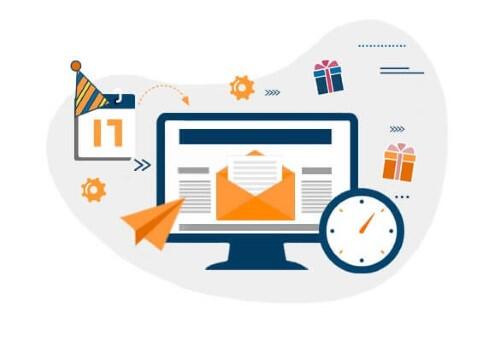In the ever-evolving landscape of digital marketing, one tool has stood the test of time, continually proving its effectiveness in fostering connections, driving engagement, and nurturing customer relationships — email marketing. As businesses navigate the dynamic terrain of online communication, the significance of a well-crafted email campaign cannot be overstated.
Email marketing serves as a direct conduit between businesses and their audience, offering a personalized and targeted approach that transcends the limitations of other marketing channels. Its adaptability to changing consumer behaviors, cost-effectiveness, and unparalleled return on investment (ROI) make it an indispensable component of successful digital strategies.
In this comprehensive guide, we delve into 10 Email Marketing Strategies designed to elevate your email campaigns to new heights. From segmentation and personalization to automation and responsive design, each strategy is a building block contributing to the success of your email marketing endeavors. Join us on this journey as we explore the intricacies of leveraging email marketing for enhanced engagement, brand loyalty, and measurable business growth.
See also our Article about What is Email Marketing and how to do it successfuly
Ready to unlock the full potential of your email campaigns? Let's dive in.
- Segmentation: Unlocking the Power of Precision Targeting

In the vast landscape of email marketing, not all subscribers are created equal. Recognizing the diversity within your audience and tailoring your messages accordingly is the essence of segmentation. This strategy involves categorizing your email listbased on specific criteria, allowing you to send more personalized and relevant content to distinct groups.
The Significance of Segmentation:
Segmentation is not merely a convenience; it's a strategic necessity. By dividing your audience into segments based on demographics, behaviors, or preferences, you gain the ability to create targeted campaigns that resonate with specific subsets of your subscribers. This precision targeting enhances engagement and increases the likelihood of conversions.
How to Segment Effectively:
-
Demographic Segmentation:
- Grouping subscribers based on demographic factors such as age, gender, location, and occupation enables you to tailor content to their unique characteristics.
-
Behavioral Segmentation:
- Understanding how subscribers interact with your emails, website, or products allows you to create campaigns that align with their behaviors. This could include categorizing users based on their purchase history, website visits, or engagement levels.
-
Preferences and Interests:
- Knowing what your subscribers are interested in or their communication preferences allows for hyper-targeted messaging. This could involve segmenting based on product preferences, content engagement, or communication frequency.
Examples of Successful Segmentation Strategies:
- An e-commerce company might segment customers based on their purchase history to send personalized product recommendations.
- A content-based website might segment subscribers according to their preferred content categories for targeted newsletters.
Implementing Segmentation in Your Campaigns:
Most email marketing platforms offer robust segmentation features. Take advantage of these tools to create dynamic segments that evolve with your audience's changing behaviors and preferences.
Segmentation is the foundation upon which personalized and highly targeted email campaigns are built. By understanding the unique characteristics of each segment, businesses can tailor their messages to resonate with the diverse needs of their audience, ultimately driving better engagement and conversions.
- Personalization: Crafting Tailored Experiences for Maximum Impact

In the realm of email marketing, personalizationis the secret sauce that transforms generic messages into compelling, individualized experiences. It goes beyond merely addressing recipients by their first names; true personalization involves understanding your audience on a deeper level and delivering content that resonates with their unique preferences and behaviors.
The Power of Personalization:
Personalization is not just a trend; it's a fundamental shift in how brands communicate with their audience. It acknowledges the individuality of each subscriber, making them feel seen and valued. Studies consistently show that personalized emails result in higher open rates, click-through rates, and overall engagement.
Techniques for Incorporating Personalization:
-
Dynamic Content:
- Utilize dynamic content blocks that adapt based on the recipient's preferences or past interactions. This could include showcasing products they've previously viewed or tailored content recommendations.
-
Behavioral Triggers:
- Implement automated behavioral triggers, such as sending a follow-up email after a specific action (e.g., a purchase or website visit). These triggers provide timely and relevant communication.
-
Personalized Recommendations:
- Leverage data to offer personalized product or content recommendations. Analyze past behavior and preferences to suggest items that align with the individual's interests.
Real-world Examples of Successful Personalization:
- An online retailer sending personalized product recommendations based on the customer's browsing and purchase history.
- A content platform curating newsletters with articles tailored to the subscriber's favorite topics.
The Impact on Customer Experience:
Personalization extends beyond the content of the email; it enhances the overall customer experience. Subscribers are more likely to engage with brands that understand and cater to their individual needs, fostering a sense of loyalty and connection.
The Role of Data in Personalization:
Effective personalization relies on data. Collect and analyze relevant data points to create a comprehensive understanding of your audience. This includes information on their preferences, behaviors, and interactions with your brand.
Incorporating Personalization in Your Email Strategy:
Most modern email marketing platforms offer robust personalization features. Experiment with various personalization techniques and closely monitor performance metrics to refine and optimize your approach over time.
In essence, personalization is the bridge between generic mass communication and meaningful, individual connections. By infusing your email campaigns with personal touches, you not only capture attention but also create lasting impressions that drive engagement and build brand affinity.
- Automation: Streamlining Your Efforts for Targeted Engagement

In the fast-paced world of digital marketing, time is of the essence, and here's where automation takes center stage. Email automation empowers businesses to deliver timely, relevant messages to their audience without the need for manual intervention. Whether it's a welcome series for new subscribers or a strategic drip campaign, automation ensures that your messages reach the right people at the right time.
Benefits of Email Automation:
-
Efficiency and Time Savings:
- Automation allows you to set up and schedule email campaigns in advance, reducing the need for manual effort. This efficiency is particularly valuable for businesses with limited resources.
-
Timely and Targeted Communication:
- Automated campaigns can be triggered based on specific actions or milestones, ensuring that subscribers receive messages at optimal moments. This targeted approach enhances the relevance of your communications.
-
Lead Nurturing and Customer Lifecycle Management:
- Automation is instrumental in nurturing leads through the sales funnel. From onboarding sequences to post-purchase follow-ups, automated workflows guide subscribers through various stages of the customer lifecycle.
Types of Automated Email Campaigns:
-
Welcome Emails:
- Instantly engage new subscribers with a series of welcome emails that introduce them to your brand, products, or services.
-
Drip Campaigns:
- Nurture leads over time by sending a series of scheduled, sequential emails. Drip campaigns are effective for delivering content or promotions in a gradual manner.
-
Abandoned Cart Emails:
- Recover potentially lost sales by automatically sending emails to users who abandon their shopping carts. These emails can include incentives or reminders to complete the purchase.
Setting Up and Optimizing Automated Email Sequences:
-
Define Goals and Triggers:
- Clearly outline the goals of your automated campaign and identify the triggers that initiate each email.
-
Segmentation for Personalization:
- Leverage segmentation to personalize automated emails based on the recipient's characteristics or behaviors.
-
A/B Testing:
- Continuously optimize automated sequences through A/B testing. Experiment with different subject lines, content, and send times to refine performance.
Real-world Examples of Successful Automation:
- A SaaS company sending onboarding emails to new trial users, guiding them through key features and use cases.
- An e-commerce brand automating post-purchase emails to request reviews and provide related product recommendations.
Choosing the Right Automation Tools:
Select an email marketing platform that offers robust automation features. Consider factors such as ease of use, scalability, and integration capabilities with other tools in your marketing stack.
Automation is the heartbeat of efficient email marketing, allowing businesses to nurture relationships, drive conversions, and deliver a seamless customer experience without constant manual oversight.
- Mobile Optimization: Captivating Your Audience on Every Screen Size
In today's digital landscape, where users are seamlessly transitioning between devices, mobile optimization is no longer a luxury but a necessity. With a significant portion of email opens occurring on mobile devices, ensuring that your emails provide a seamless and visually appealing experience across various screen sizes is paramount.
The Rise of Mobile Email Engagement:
Mobile devices have become integral to our daily lives, and email is no exception. According to recent studies, over half of all email opens happen on mobile devices. As such, optimizing your emails for mobile is not just about staying current; it's about meeting your audience where they are.
Why Mobile Optimization Matters:
-
User Experience:
- A positive user experience on mobile devices enhances engagement and encourages recipients to interact with your content.
-
Responsive Design:
- Implementing responsive design ensures that your emails adapt to different screen sizes, providing a visually consistent and enjoyable experience.
-
Avoidance of Unintended Actions:
- Mobile optimization helps prevent accidental clicks or unintended actions, reducing frustration for users and ensuring a seamless interaction.
Mailpro: Your Partner in Mobile-Optimized Email Campaigns:
When it comes to mobile-optimized email campaigns, the choice of your email marketing platform matters. Mailpro, a leading email marketing solution, understands the importance of mobile optimization for effective communication.
Mailpro's Mobile-Friendly Features:
- Responsive Templates: Mailpro offers a range of responsive email templates designed to look great on screens of all sizes, ensuring your messages are visually appealing across devices.
- Preview and Testing: The platform allows you to preview and test your emails in a mobile-friendly environment before sending, ensuring that your content appears as intended on various devices.
- Analytics on the Go: Access real-time analytics and performance metrics on your mobile device, empowering you to monitor and optimize your campaigns on the fly.
Best Practices for Mobile Optimization:
-
Concise and Scannable Content:
- Craft concise and scannable content that is easy to digest on smaller screens.
-
Optimized Images:
- Optimize images for faster loading times on mobile devices without compromising quality.
-
Clear Calls-to-Action (CTAs):
- Ensure that your CTAs are prominently displayed and easily tappable on mobile screens.
Real-world Examples of Successful Mobile Optimization:
- A retail brand using a single-column layout and large, tappable buttons in their mobile-optimized emails.
- A news outlet employing responsive design to deliver a seamless reading experience on mobile devices.
Mobile optimization is not just a checkbox; it's a strategic imperative for effective email marketing. With Mailpro's suite of mobile-friendly features, you can confidently engage your audience across devices, delivering impactful messages that resonate wherever your subscribers may be.
- Compelling Subject Lines: Capturing Attention in the Inbox
In the crowded landscape of email inboxes, a compelling subject line is your golden ticket to capturing attention and enticing recipients to open your emails. Crafting subject lines that stand out, pique curiosity, and convey value is an art that can significantly impact the success of your email campaigns.
The Significance of Compelling Subject Lines:
The subject line is the first impression your email makes on recipients. A well-crafted subject line not only encourages opens but also sets the tone for the entire email, influencing the subscriber's perception of your brand.
Strategies for Crafting Compelling Subject Lines:
-
Clarity and Conciseness:
- Keep subject lines clear, concise, and to the point. Avoid ambiguity and ensure that the main message is easily understood.
-
Personalization:
- Incorporate personalization elements, such as the recipient's name or tailored content recommendations, to create a sense of individual connection.
-
Urgency and Scarcity:
- Convey a sense of urgency or scarcity when applicable. Limited-time offers or exclusive deals can create a compelling reason for recipients to open your email promptly.
A/B Testing for Subject Line Optimization:
A/B testing, or split testing, is a valuable technique for refining your subject lines. Experiment with variations in language, length, or tone to understand what resonates best with your audience.
Examples of Compelling Subject Lines:
-
"Unlock Exclusive Access: Your VIP Invitation Inside!"
- This subject line combines personalization ("Your") with the allure of exclusivity to drive curiosity.
-
"Last Chance: 24 Hours Left to Claim Your 20% Discount!"
- Communicates urgency and a clear call to action, encouraging immediate opens.
Avoiding Common Pitfalls:
-
Avoiding Clickbait:
- While creating intrigue is essential, avoid misleading subject lines that may disappoint or frustrate recipients.
-
Avoiding Spam Triggers:
- Steer clear of spammy language or excessive use of symbols, as this can trigger spam filters and negatively impact deliverability.
Mailpro's Subject Line Tips:
When using Mailpro for your email campaigns, consider these additional tips for crafting compelling subject lines:
- Personalization Tags: Leverage Mailpro's personalization features to dynamically include the recipient's name in the subject line.
- Emoji Integration: Experiment with emojis to add visual appeal and convey emotions in your subject lines.
- Preview Text Optimization: Utilize Mailpro's preview text feature to complement your subject line and provide additional context.
Crafting compelling subject lines is both an art and a science. By combining creativity with strategic testing, you can elevate your email campaigns and ensure that your messages stand out amidst the email clutter.
- Clear Call-to-Action (CTA): Guiding Subscribers Toward Action

A well-defined call-to-action(CTA) is the driving force behind every successful email campaign. It's the roadmap that guides subscribers on the journey from opening your email to taking the desired action, be it making a purchase, downloading content, or signing up for an event. Crafting clear and compelling CTAs is essential for converting email engagement into tangible results.
The Significance of Clear CTAs:
The CTA is the linchpin that transforms engagement into action. Whether your goal is to drive sales, increase newsletter sign-ups, or encourage social media shares, a well-crafted CTA provides a straightforward path for subscribers to follow.
Elements of an Effective CTA:
-
Clarity:
- Ensure that your CTA is clear and unambiguous. Subscribers should immediately understand what action you want them to take.
-
Visibility:
- Make your CTA visually prominent. Use contrasting colors, ample white space, and a font size that ensures your CTA stands out within the email.
-
Action-Oriented Language:
- Use action verbs that convey a sense of urgency or excitement. Phrases like "Shop Now," "Discover More," or "Get Started" prompt immediate action.
Strategies for Crafting Compelling CTAs:
-
FOMO (Fear of Missing Out):
- Create a sense of urgency or exclusivity to encourage immediate action. Limited-time offers or exclusive access can drive FOMO and boost click-through rates.
-
Benefit-Oriented Language:
- Clearly articulate the benefit or value of clicking the CTA. Subscribers should understand what's in it for them and why taking action is worthwhile.
-
Mobile Optimization:
- Ensure that your CTAs are optimized for mobile devices. This includes a design that is touch-friendly and a font size that remains legible on smaller screens.
Real-world Examples of Compelling CTAs:
-
"Claim Your Free Trial Today!"
- This CTA combines action-oriented language with the appeal of a free trial, enticing subscribers to take immediate action.
-
"Shop Now for Exclusive 24-Hour Access!"
- The combination of urgency and exclusivity prompts subscribers to explore the offer without delay.
Mailpro's CTA Enhancement Tips:
When using Mailpro for your email campaigns, leverage the platform's features to enhance your CTAs:
- Button Design Options: Explore Mailpro's button design options to create visually appealing and clickable CTAs.
- Link Tracking: Utilize Mailpro's link tracking feature to monitor the performance of your CTAs and optimize based on real-time insights.
- A/B Testing: Experiment with different CTA variations through Mailpro's A/B testing capabilities to identify the most effective approach.
- A/B Testing: Refining Your Strategy for Optimal Results
In the dynamic landscape of email marketing, A/B testing emerges as a strategic powerhouse, offering marketers the ability to experiment, learn, and refine their campaigns systematically. Also known as split testing, A/B testing involves comparing two variations of an element to determine which performs better. From subject lines to images and CTA buttons, A/B testing empowers you to optimize your email campaigns for maximum impact.
The Power of A/B Testing:
A/B testing is not a mere luxury; it's a fundamental tool for understanding your audience and refining your approach. It allows you to make data-driven decisions, uncovering insights into what resonates best with your subscribers.
Elements to A/B Test in Email Campaigns:
-
Subject Lines:
- Experiment with different subject lines to gauge which ones lead to higher open rates. Test variations in length, tone, and personalization.
-
Content and Copy:
- Test different approaches to your email content, including the tone, writing style, and the positioning of key messages.
-
Images and Media:
- Explore how different images or media elements impact engagement. This could include variations in visuals, multimedia content, or the inclusion of user-generated content.
-
CTAs (Call-to-Action):
- Test variations in your CTAs, such as different text, colors, or placement within the email. Identify which CTAs drive the highest click-through rates.
Setting Up A/B Tests:
-
Define Your Objective:
- Clearly outline the specific goal of your A/B test. Whether it's increasing open rates, click-through rates, or conversions, a well-defined objective guides the testing process.
-
Select a Variable to Test:
- Choose a single element to test in each campaign. Testing multiple elements simultaneously can make it challenging to pinpoint the factors contributing to performance differences.
-
Randomized Sample:
- Divide your email list into random, equal segments to ensure a fair comparison between the variations.
Analyzing and Implementing Results:
-
Monitor Key Metrics:
- Track relevant metricsfor each variation, such as open rates, click-through rates, and conversion rates.
-
Statistical Significance:
- Ensure that your results have statistical significance before drawing conclusions. This minimizes the risk of making decisions based on random fluctuations.
-
Implementing Changes:
- Once you identify a winning variation, implement the changes in your future campaigns to capitalize on what resonates best with your audience.
Real-world Examples of Successful A/B Testing:
- Subject Line Testing: A retail brand tests two subject lines—one emphasizing urgency and the other highlighting exclusivity. The urgency-focused subject line leads to a 15% increase in open rates.
- CTA Button Color Testing: An e-commerce site tests two variations of a CTA button—one in red and the other in green. The red button outperforms, resulting in a 20% higher click-through rate.
A/B testing is an ongoing process of refinement and optimization. By systematically testing and learning from your campaigns, you can fine-tune your email marketing strategy and consistently deliver content that resonates with your audience.
- Responsive Design: Engaging Audiences Across Every Device
In an era where users seamlessly switch between various devices, responsive design stands as a cornerstone for effective email marketing. Ensuring that your emails are visually appealing and functional across desktops, tablets, and mobile devices is not just a best practice; it's imperative for capturing and retaining the attention of your diverse audience.
The Importance of Responsive Design:
Responsive design goes beyond aesthetics; it's about delivering a consistent and optimized user experience regardless of the device. With the majority of email opens occurring on mobile devices, an email that adapts seamlessly to different screen sizes is a prerequisite for engagement.
Why Visual Appeal Matters:
-
Enhanced Readability:
- A responsive design ensures that your content is displayed legibly on screens of all sizes, preventing users from having to pinch or zoom to read your message.
-
Professionalism and Trust:
- A well-designed email reflects professionalism and instills trust. Users are more likely to engage with content that appears polished and visually cohesive.
-
Mobile Prevalence:
- With the ubiquity of mobile devices, an email that isn't optimized for mobile is likely to be dismissed or deleted, leading to missed opportunities for engagement.
Key Components of Responsive Design:
-
Fluid Grids:
- Implement fluid grids that automatically adjust the layout of your email based on the screen size. This ensures a seamless transition from large desktop screens to smaller mobile displays.
-
Media Queries:
- Use media queries to apply specific styles or adjustments based on the device characteristics, such as screen width or orientation.
-
Touch-Friendly Elements:
- Design elements, including buttons and links, to be touch-friendly on mobile devices, preventing accidental clicks or frustrating user experiences.
Testing Responsiveness:
-
Email Preview Tools:
- Leverage email preview tools to test how your email renders across various devices before sending it to your entire list.
-
A/B Testing for Design Elements:
- Conduct A/B testing specifically for design elements to identify the layouts and styles that resonate best with your audience.
Real-world Examples of Successful Responsive Design:
- Single-Column Layouts: Many successful email campaigns adopt a single-column layout for simplicity and ease of navigation on smaller screens.
- Interactive Elements: Some brands incorporate interactive elements that enhance engagement on touch-enabled devices without sacrificing the experience on larger screens.
Best Practices for Responsive Design:
-
Limit File Sizes:
- Optimize images and limit file sizes to ensure faster loading times, particularly on mobile networks.
-
Consistent Branding:
- Maintain consistent branding across devices to reinforce your brand identity and improve recognition.
-
Testing Across Email Clients:
- Ensure responsiveness across various email clients, as rendering may vary.
Responsive design is not just a design trend; it's a fundamental aspect of user-centric email marketing. By prioritizing a seamless and visually appealing experience across devices, you position your email campaigns for success and engagement.
- Feedback and Analytics: Navigating Success Through Data

In the realm of email marketing, data is not just a byproduct; it's the compass guiding your strategy. Feedback and analytics provide invaluable insights into how your audience interacts with your emails, empowering you to make informed decisions, refine your approach, and continually enhance your campaigns.
The Significance of Feedback:
Feedback is the voice of your audience, offering direct insights into their preferences, expectations, and reactions. Whether it's through surveys, direct responses, or social media, gathering feedback is a proactive step toward understanding your subscribers on a deeper level.
Channels for Gathering Feedback:
-
Surveys and Polls:
- Embed surveys or pollsdirectly within your emails to collect quantitative data on subscriber preferences or gather qualitative feedback on specific aspects of your campaigns.
-
Social Media Listening:
- Monitor social media channels for mentions, comments, and discussions related to your email campaigns. Social media platforms can provide a real-time pulse on how your audience is responding.
-
Direct Replies:
- Encourage subscribers to reply directly to your emails. This direct communication channel can yield valuable insights and foster a sense of engagement.
Utilizing Analytics for Optimization:
-
Open Rates:
- Analyze open rates to gauge the effectiveness of your subject lines and overall email appeal. Identify trends and patterns to refine your subject line strategy.
-
Click-through Rates (CTR):
- Track CTR to understand which elements, such as images, CTAs, or links, resonate most with your audience. Use this information to optimize future campaigns.
-
Conversion Rates:
- Measure conversion rates to assess the success of your email in driving the intended action, whether it's a purchase, sign-up, or download.
Data-Driven Decision Making:
-
Segmentation Refinement:
- Use feedback and analytics to refine your segmentation strategy. Identify commonalities among high-engagement segments and tailor future campaigns accordingly.
-
Content Optimization:
- Analyze data on content performance to optimize the type of content you include in your emails. Identify content formats that generate higher engagement.
-
Timing and Frequency Adjustments:
- Evaluate the timing and frequency of your campaigns based on subscriber behavior. Use analytics to identify peak engagement times and refine your send schedule.
Real-world Examples of Successful Feedback Integration:
- Iterative Design: An e-commerce brand consistently gathers feedback on new email designs, iteratively refining layouts and visuals based on customer preferences.
- Product Recommendations: An online retailer uses analytics to track the performance of product recommendations, continually adjusting algorithms to showcase items that resonate with the audience.
Continuous Improvement Through Analytics:
-
Regular Review and Analysis:
- Schedule regular reviews of your email analytics to identify trends and patterns. Continuous analysis allows for agile adjustments to your strategy.
-
Benchmarking Against Goals:
- Benchmark your performance against predefined goals. Use analytics to measure success and identify areas for improvement.
Moving Beyond Vanity Metrics:
While open rates and click-through rates offer valuable insights, focus on how these metrics align with your overarching business goals. Analytics should not only inform your email strategy but also contribute to the overall success of your organization.
- Compliance and Transparency: Building Trust in Every Email
In the ever-evolving landscape of email marketing, compliance and transparency are not just legal obligations; they are the bedrock of trust between brands and their subscribers. Respecting privacy regulations and being transparent in your communication builds credibility, fosters positive relationships, and ensures the longevity of your email marketing endeavors.
The Importance of Compliance:
-
Legal Obligations:
- Adhering to data protection laws, such as GDPR (General Data Protection Regulation) and CAN-SPAM, is not only a legal requirement but a fundamental ethical practice. Compliance safeguards your brand from legal repercussions and demonstrates a commitment to respecting user privacy.
-
Opt-In Mechanisms:
- Implement robust opt-in mechanisms to ensure that subscribers willingly and knowingly consent to receiving your emails. Clearly communicate the nature of the content they can expect and how often they will hear from you.
Transparency as a Trust Builder:
-
Clear Privacy Policies:
- Provide easy access to your privacy policy, detailing how you collect, use, and safeguard subscriber data. Transparency about data practices builds confidence among subscribers.
-
Subscription Preferences:
- Allow subscribers to easily manage their subscription preferences. Clearly communicate how to opt out and provide a straightforward unsubscribe process.
-
Email Sender Identification:
- Ensure that your email sender identification is clear and recognizable. Use a recognizable sender name and a legitimate reply-to address to enhance transparency.
The Role of Consent in Email Marketing:
-
Explicit Consent:
- Collect explicit consent before adding individuals to your email list. This is especially crucial for marketing to individuals in regions covered by stringent data protection laws like GDPR.
-
Unsubscribe Mechanism:
- Make the unsubscribe process straightforward and easily accessible. Including an unsubscribe link in every email not only ensures compliance but also demonstrates respect for subscriber choices.
Real-world Examples of Transparent Practices:
- Opt-In Confirmation Emails: A travel agency sends a confirmation email after users opt in, reiterating the type of content they will receive and the frequency of communication.
- Subscription Preferences Center: An e-commerce brand provides a subscription preferences center where subscribers can customize the type of emails they want to receive, ensuring transparency in communication.
Staying Informed About Legal Changes:
-
Regular Compliance Audits:
- Conduct regular compliance audits to ensure that your email marketing practices align with the latest legal requirements. Stay informed about changes in privacy laws that may impact your strategy.
-
Education and Training:
- Educate your marketing team about compliance requirements and invest in training to keep them abreast of best practices. Compliance is a collective responsibility.
Building a Culture of Trust:
Compliance and transparency go beyond legal checkboxes; they contribute to building a culture of trust. Subscribers are more likely to engage with brands that prioritize their privacy and communicate openly about data practices.
Conclusion: Elevating Your Email Marketing Strategy for Success
As we navigate the intricate landscape of email marketing, it becomes evident that success hinges on a dynamic interplay of strategies that go beyond mere delivery to foster engagement, trust, and lasting relationships with your audience.
From crafting compelling subject lines that captivate attention to employing responsive design that ensures a seamless experience across devices, each facet plays a crucial role in the effectiveness of your campaigns. The journey doesn't end with sending emails; it extends into the realm of feedback and analytics, where data transforms into actionable insights, guiding your strategy towards continual refinement.
Compliance and transparency emerge as non-negotiable pillars, not just for legal adherence but as fundamental elements of a trustworthy relationship with your subscribers. By respecting privacy regulations, obtaining explicit consent, and transparently communicating your data practices, you not only comply with the law but also build a foundation of trust that strengthens your brand's reputation.
In this ever-evolving landscape, the key is not just to adopt these strategies in isolation but to interweave them into a cohesive tapestry that resonates with your unique audience. Whether you're a seasoned marketer or just embarking on your email marketing journey, the strategies outlined here provide a roadmap for elevating your campaigns to new heights.
Remember, the heart of successful email marketing lies in understanding your audience, adapting to their preferences, and delivering content that adds value to their lives. As you incorporate these strategies into your approach, embrace the iterative nature of email marketing—test, learn, and adapt. The journey to email marketing success is not a destination; it's an ongoing evolution fueled by creativity, data-driven insights, and a commitment to building meaningful connections.
Elevate your email marketing strategy, and let each campaign be a testament to your brand's dedication to delivering content that inspires, engages, and leaves a lasting impact on your audience.
